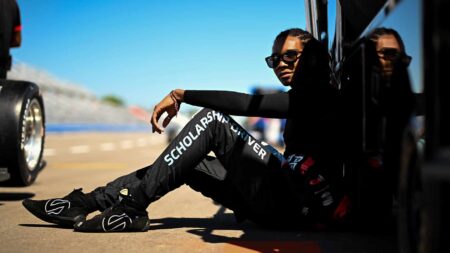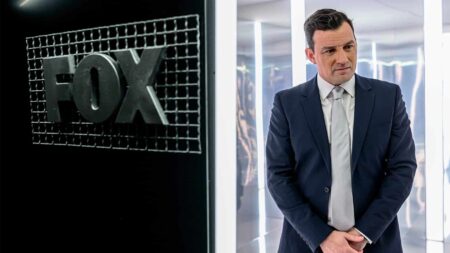
Lundgaard: McLaren can make history with F1/IndyCar double win
Christian Lundgaard is McLaren's new IndyCar star – and wants to make history by helping the team win both in F1 at Bahrain and at Long Beach Stateside on the same day
On Monday the IndyCar Series fined Hélio Castroneves US$60,000 and put him on probation for the rest of the year after he ignored a black flag in the closing laps of the July 25 round at Edmonton, and heaped invective on a couple of IRL officials immediately after the race. Castroneves was black-flagged while leading following the race’s final restart. Chief steward Brian Barnhart said the Brazilian had weaved to block team-mate Will Power and violated IndyCar’s one-move-only rule.

“This rule is unique to Indycar racing,” said Barnhart. “It was put in place to protect our competitors, officials and fans, prevent unnecessary damage to these cars and allow for more passing opportunities. Bad things happen when these cars touch and there have been serious incidents with major consequences on temporary circuits throughout Indycar history. With the new wheel interlocking prevention technology that is coming in our 2012 formula we will be revaluating the rule in the future.”

But many people saw it as just good, hard racing. Castroneves squeezed Power at the apex of the first turn but gave the Australian room to race and enjoyed a better line into the next sequence of corners, while Power took a tight line and lost momentum and a place to Scott Dixon. Compared to the aggressive moves we’ve seen from Michael Schumacher in Formula 1, Castroneves’ manoeuvres in Edmonton were fair and sportsmanlike.

Things began to go wrong for the emotional Castroneves when he refused to pull in for the black flag. He was penalised 20 seconds and placed at the end of the lead lap in 10th. After clambering out of his car Hélio allowed his feelings to overflow, scuffling with two officials in the pitlane and declaring on TV that IndyCar should talk to his lawyers.
“This sport is so close and competitive that emotions are always on display,” said IndyCar CEO Randy Bernard (below). “However, that does not justify the post-race conduct of Hélio toward series officials. This is a very serious matter and we weighed all the options, including suspension. But we felt suspension would hurt the fans more than anyone else. Fans have paid money to watch the best drivers in the world and many bought their tickets for upcoming events with the expectation of watching Hélio. He is a great ambassador for this sport and we know his actions after the Edmonton race are not indicative of his normal behaviour.”

Castroneves issued his own statement: “I want to thank Randy Bernard for taking the time to meet with me in Indianapolis today. I regret what occurred following the race in Edmonton and I apologise for my behaviour as I let my emotions get the better of me. Although my disappointment with being black-flagged while leading the race with a few laps to go will probably remain with me, I understand and accept the league’s decision to penalise me for my reaction. I am ready to move forward and I’m hoping to add to Team Penske’s success at Mid-Ohio.”
Over the past 20 years as F1 has moved too far in one direction, IndyCar has moved too far in the other. As first Ayrton Senna and then Schumacher rewrote the code of conduct in F1 which became a much harder sport, IndyCar tried to put on as nice a face as possible as the CART/IRL war dragged the sport down. It was the antithesis of what once made USAC and then CART a tough, unique form of racing.
I remember Bobby Unser raging at Gordon Johncock after a wheel-banging episode at Milwaukee in 1981. Unser was the archetypal hard man of Indycar racing and he called Johncock every name in the book to both Gordie’s face and the media. But Johncock was an equally hard man and he just smirked at Bobby. It was great theatre and helped sell plenty of tickets, and that kind of controversy is part of what today’s Indycar desperately needs rather than Castroneves being reduced to a foot-shuffling, naughty college boy.
Instead of following the old USAC way, contemporary Indycar racing has gone down the path of the SCCA, which was renowned for its gentlemanly rules of conduct rather than the rough and tumble manners of USAC and NASCAR. In fact, all forms of American road racing have been infected by the SCCA’s amateurish ways, so that every young European racer who comes to the US has a tough time adapting to our more gentlemanly rules, while any young American going to Europe has an equally difficult time adjusting to the harsher cut and thrust of the racing.
But the fact remains that in a country where NASCAR’s ‘Have at it boys’ philosophy sets the standard and dominates the market, IndyCar is becoming an increasingly irrelevant form of motor racing.

Christian Lundgaard is McLaren's new IndyCar star – and wants to make history by helping the team win both in F1 at Bahrain and at Long Beach Stateside on the same day

Louis Foster starts his IndyCar journey this weekend in St Petersburg – can he emulate other British heroes like Nigel Mansell and Dan Wheldon?

Myles Rowe has rocketed through IndyCar's junior ladder with a story like no other – he tells James Elson why this upcoming year is more important than ever

Drive to Survive star Will Buxton has made the jump across the Atlantic to front Fox's new IndyCar coverage – he explained to James Elson why he thinks the championship is the most exciting series out there